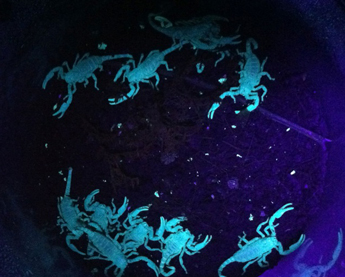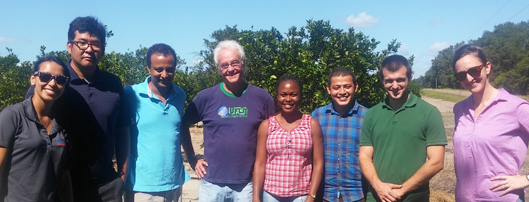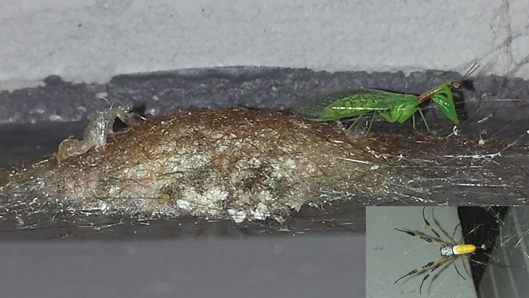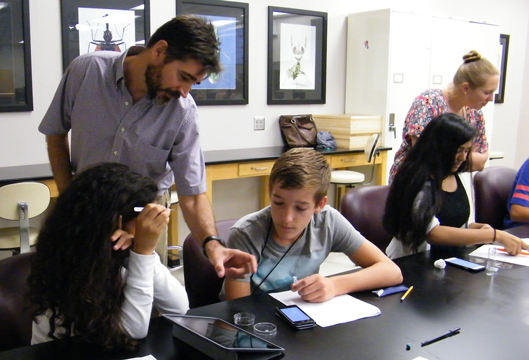- Faculty News
- Student News
- Lab News
- Publications
- Meetings and Presentations
- Outreach
- Grants
- Announcements
- About This Newsletter

ABOVE: The baby scorpions are growing-up and now glow under UV light.
A note from Dr. Siegfried
It is just over a year since I interviewed for Department Chair, and I just completed my second month on the job. It seems like a good time to share some of the things that I’ve observed and that have occupied my time.
Grants: I have been delighted to see the activity around Virni Mattson’s desk (although she may have a different view). When I interviewed for the position, I made a strong pitch for being aggressive and creative in obtaining funds to support our programs. I believe that this commitment is essential to our long-term well-being and look forward to working with everyone in continuing to make this a priority at all levels for our organization. Sorry Virni!
New positions: I knew that I would have my work cut out for me when I heard about the new positions for the department. What I did not anticipate was the magnitude of our hiring. While some of the positions to be filled will be replacements, by my count, we will be hiring 14 new people to the department and across the state in the next year. To put this in perspective, the University of Nebraska has only 17 members in the whole department! The first two interviews for on-campus positions have been completed, and I look forward to seeing some new faces around the department in the near future. I appreciate all the efforts of our office staff, especially Glinda Burnett and Nancy Sanders, for scheduling, making sure refreshments were available and in general, making the process work smoothly! I would also like to thank the search committees and chairs for identifying and inviting quality candidates.
Seminar: I turned up 10 minutes late for the first seminar and spent the next 50 minutes standing in the hallway trying to peek inside! I quickly learned to show up early and was very pleased to see that interest in our seminar was consistent throughout the remainder of the semester. I believe that the departmental seminar should be part of our culture and be consistently attended by all. It is an opportunity for us to learn what happens outside the department and for us to make a good impression on our visitors. I look forward to working with Dr. Jiri Hulcr and future seminar coordinators in developing a strong tradition around seminar.
Overall, it has been a pretty incredible year and exciting two months of learning and getting to know everyone. I will continue to try and provide updates through the newsletter, but do not hesitate to stop by and say hello when it is convenient.


ABOVE: Dr. Oscar Liburd was an invited speaker in celebration of the 50th Anniversary of the Nigerian Entomological Society (October 6-9). His talk was titled "Mitigation factors to reduce farmers reliance on toxic pesticides." He received a plaque from the Nigerian Entomological Society honoring his work to reduce pesticide inputs on farms in developing countries.
 Dr. Christine W. Miller and Dr. Andrea Lucky have been denoted a UF Global Fellow for 2016. The UFIC Global Fellows Program provides workshops and travel funds to help faculty advance an international research agenda.
Dr. Christine W. Miller and Dr. Andrea Lucky have been denoted a UF Global Fellow for 2016. The UFIC Global Fellows Program provides workshops and travel funds to help faculty advance an international research agenda.
 Dr. Jennifer Gillett-Kaufman has been in the news for her work with Florida olive producers. She also had the opportunity to address the North Florida Congressional representative's staff and aides from Washington DC, on of November 12th at PSREU in Citra.
Dr. Jennifer Gillett-Kaufman has been in the news for her work with Florida olive producers. She also had the opportunity to address the North Florida Congressional representative's staff and aides from Washington DC, on of November 12th at PSREU in Citra.
 Would you like to be an Assistant Professor in Plant Disease Vector Entomology? We have 10 faculty positions available now! Know someone who wants a #UFBugs job? Share this link with people you would like to have as members of our team.
Would you like to be an Assistant Professor in Plant Disease Vector Entomology? We have 10 faculty positions available now! Know someone who wants a #UFBugs job? Share this link with people you would like to have as members of our team.


ABOVE: Dr. James P. Cuda returned to Gainesville on November 2nd after spending the last two months (September and October) in Brazil on a sabbatical that was funded by a Fulbright Scholarship. Dr. Cuda conducted field research on Brazilian peppertree and also delivered an invited lecture on weed biological control to a group of 30 forest engineering students at the Universidade Regional de Blumenau.
 Dr. Xavier Martini a Postdoctoral Associate at the Citrus Research and Education Center is the inaugural recipient of the Postdoc of the Month Award presented by the Postdoc Journal, a Journal of Postdoctoral Research and Postdoctoral Affairs.
Dr. Xavier Martini a Postdoctoral Associate at the Citrus Research and Education Center is the inaugural recipient of the Postdoc of the Month Award presented by the Postdoc Journal, a Journal of Postdoctoral Research and Postdoctoral Affairs.

ABOVE: Students taking Dr. Tesfa Mengistu's Nematode Diagnostics course this Fall traveled to Avon Park, in Central Florida, located in the heart of Florida’s citrus production area. The group was received by Nematologist, Dr. Larry Duncan (Citrus Research and Education Center, Lake Alfred). Dr. Duncan took the group to a commercial citrus grove where he gave a small lecture about nematode species of major economic importance in Florida. These include the citrus nematode (Tylenchulus semipenetrans), causal agent of slow decline, the burrowing nematode (Radopholus similis), causal agent of spreading decline, and the lesion nematode (Pratylenchus coffeae), causal agent of citrus slump. Dr. Duncan emphasized the importance of good cultural practices. He also demonstrated the collection of representative samples for the best estimate of plant-parasitic nematode populations in citrus groves.
Need to name that bug? A host of experts are available to help Floridians identify any insect or related arthropod. If a mystery creature has six or more legs, the UF Insect ID Lab is the place to call.

ABOVE: This golden silk spider, Nephila clavipes (L.) (Tetragnathidae), happened to spin her web on Dr. Joe Cicero's front porch, allowing him to observe her in passing many times a day, and catch a rare sight of the emergence of Mantispa viridis Walker. The exuviae can be seen at the opposite end of the egg sac.
Mantispids are well known for three aspects. They are known for the functional convergence of prothoracic length and front legs as that of praying mantids. In mantids, the tibia and femora are heavily spined and opposable to clamp down on prey, while in mantispids, the same action is performed by the opposing tibia and first tarsal segment. Secondly, many mantispids are batesian mimics, such as the vespid mimic Climaciella, and the chrysopid mimic showcased in this article. Lastly, many mantispids are spider egg predators, while others develop on larval Hymenoptera, Lepidoptera, and Coleoptera.
Some larvae, like that of M. viridis, bore directly through the silk envelope to access the spider eggs. Others phoretically board the spider, hiding around the pedicel or inside the book lungs and feed on the host’s hemolymph while waiting for the sac to be fashioned.
Lyle Buss is the UF/IFAS Insect ID Lab manager.
 Think it might be a nematode problem? The Nematode Assay Laboratory serves Florida and other states by providing nematode assays and expert advice regarding nematode management.
Think it might be a nematode problem? The Nematode Assay Laboratory serves Florida and other states by providing nematode assays and expert advice regarding nematode management.
For more information on the Nematode Assay Laboratory, please contact lab manager Dr. Tesfa Mengistu.
Baniszewski J, Weeks ENI, Cuda JP. 2015. Impact of refrigeration on eggs of the hydrilla tip miner Cricotopus lebetis: larval hatch rate and subsequent development. Journal of Aquatic Plant Management. 53: 209-215.
Brar GS, Meyer W, Stelinski LL. 2015. Effects of methoprene, a juvenile hormone analog, on survival of various developmental stages, adult emergence, reproduction, and behavior of Asian citrus psyllid, Diaphorina citri Kuwayama. Pest Management Science. 71: 1657-1665.
Cicero JM, Stansly PA, Brown JK. 2015. Functional anatomy of the oral region of the potato psyllid (Hemiptera: Psylloidea: Triozidae). Annals of the Entomological Society of America. 108: 743-761.
Hood GR, Forbes AA, Powell THQ, Egan SP, Hamerlinck G, Smith JJ, Feder JL. 2015. Sequential divergence and the multiplicative origin of community diversity. Proceedings of the National Academy of Sciences. on-line early doi: 10.1073/pnas.1424717112. There was a write-up in The Wall Street Journal about this paper!
Machtinger ET, Geden CJ, Kaufman PE, House AM. 2015. Use of pupal parasitoids as biological control agents of filth flies on equine facilities. Journal of Integrated Pest Management. 6:16 DOI:10.1093/jipm/pmv015.
Martini X, Garrigues J-F, Hemptinne J-L. 2015. Egg-cannibalism by ladybird larvae is less frequent than expected despite the nutritional benefit accrued to cannibals. Journal of Applied Entomology. 139: 609-617.
Narouei-Khandan HA, Halbert SE, Worner SP, van Bruggen AHC. 2015. Global climate suitability of citrus huanglongbing and its vector, the Asian citrus psyllid, using two correlative species distribution modeling approaches, with emphasis on the USA. European Journal of Plant Pathology. In press on-line.
Prade P, Diaz R, Vitorino M, Cuda JP, Kumar P, Gruber B, Overholt WA. 2015. Galls induced by Calophya latiforceps (Hemiptera: Calophyidae) reduce leaf performance and growth of Brazilian peppertree. Biocontrol Science and Technology. 26: 23-34.
Serre S, Mickelsen L, Calfee MW, Wood JP, Gray MS, Scheffrahn RH, Perez R, Kern WH, Daniell N. 2015. Whole-building decontamination of Bacillus anthracis Sterne spores by methyl bromide fumigation. Journal of Applied Microbiology. In press on-line.
Sedonia S, Storer C, Hulcr J, Lucky A. 2015. Alternative preservatives of insect DNA for citizen science and other low-cost applications. Invertebrate Systematics. 29: 468-472.
 New on Featured Creatures:
New on Featured Creatures:
Florida flower thrips, Frankliniella bispinosa Morgan. Authors: Steven P. Arthurs, Moh Leng Kok-Yokomi, and Hugh Smith.
Lesser wax moth, Achroia grisella Fabricius. Authors: Ashley A. Egelie, Ashley N. Mortensen, Lynn Barber, Jessica Sullivan, and James D. Ellis.
Oblong-winged katydid, Amblycorypha oblongifolia (De Geer). Authors: Shari Linn and Jennifer L. Gillett-Kaufman.
Do you have a favorite creature? Learn how to make it into a Featured Creatures!
This past summer, high school teachers Jennifer Broo and Jessica Mahoney interned in Dr. Daniel Hahn’s lab. Working under an NSF grant (NSF-IOS-1257298), these teachers collaborated with Dr. Hahn to develop classroom lessons to accompany an assay developed in his laboratory to investigate recovery after an induced chill coma using Drosophila as a model organism. In September, these lessons debuted in Ms. Mahoney’s classroom in Edgewater High School in Orlando, Florida.
The lab was designed to allow students to witness first-hand the effects of climate change on species survivability and the interconnectedness of evolution and changing environmental conditions. The students also learned about the effects of climate change on other species, such as coral, amphibians, and birds.

ABOVE: Dr. Hahn has been involved in professional development for teachers and science enrichment programs for high school students with the UF Center for Precollegiate Education and Training (UF CPET) since 2008, working with hundreds of teachers and students.
From the Outreach Coordinator
A big thank you to the students and faculty who volunteered for our October outreach events.
- 1 October- Education Open House at FLMNH- Oliver Keller and Erin Powell
- 9 October- Homeschool Group Department Tour- Katherine Arguez and Erin Powell
- 14 October- Heart Pine Elementary School- Oliver Keller and Erin Powell
- 23 October- Kanapaha Middle School Career Day- Jeff Hertz
- 28 October- Classical Conversations Homeschool Group- Patricia Prade and Jennifer Serviss
- 29 October- My School Preschool- Dr. Rebecca Baldwin
- 29 October- Education Station and Preschool- Ashley Mortensen
Upcoming events:
- 21 November- Camp Shands Boy Scout Event
- 4 December- YOPP Inc. science days
The live critters are always a hit with children and adults alike. The critters are available for you to check out should you be leading an outreach event. We have doubles of our most popular critters, as well as various native insect species depending on the time of year. We have large wood and Plexiglas cages for viewing our native orb weaving spiders. There is one travel cage and one larger static cage. Please be sure to contact us and review the protocol on transporting and handling the critters if you are not already familiar with it. If you lead an outreach, be sure to fill out a documentation form so your event can be included in the newsletter and we can log all outreach events.
If you have any questions, please email me.
Thank you — Erin Powell, Outreach Coordinator.
If you would like to schedule an event or have any outreach questions, go to the Outreach pages on our Bug Club website and contact us.
 Getting social!
Getting social!
We have several social media sites for the Entomology & Nematology Department. To make them easily searchable, all three (YouTube, Facebook, and Twitter) have the same page name: UFEntomology. Please share these links with past students or colleagues who may have an interest in departmental activities.
Virni Mattson, our grants specialist, reports that from October 1st to October 31st our external funding for all Entomology & Nematology faculty (in Gainesville and at RECs) was $1,053,984.00. This is for 14 new awards and does not reflect money returned by PIs for project reductions.

A new NIFA Organic Agriculture Research grant for $2,000,000 was awarded to an interdisciplinary team working on organic strawberry production in the Southeast. The team consists of Dr. Oscar Liburd (Entomology), Drs. Chase and Xin (Horticulture), Dr. Marilyn Swisher (Family Youth and Community Services), and Dr. Zhifeng (Food and Resource Economics).
The team is collaborating with Florida Organic Growers Association and extension colleagues from FAMU and North Carolina A&T. Dr. Liburd's activities will focus on refining monitoring protocols for spotted wing drosophila and identifying tools for managing key pests including twospotted spider mites and spotted wing drosophila in organic strawberry.
We like to share news when it happens using our social media outlets: Twitter, Facebook and YouTube. Follow us on these sites for daily updates! When you send news, we will post it on one or more of these sites and again in the monthly newsletter. Please be sure you have permission from people in photographs you submit for publication.
UF-Bugnews-L listserv subscribers receive notices when issues are posted. Our home page has instructions for subscribing and unsubscribing.
Special thanks to Shari Linn and Nancy Sanders, who reviewed the newsletter for errors, and to Jane Medley and Don Wasik, who built the web page design.